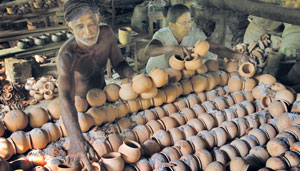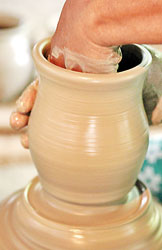It is a small family-run home-based business. Slightly off the main Kaduwela-Hanwella Road at Ranala, in a long shed behind their humble home, 50-year-old Pathma Ranjani sits at her 'wheel' turning out pot after pot, even waking up at 2 in the morning these days.
With Avurudu round the corner, the pace in their home has quickened and Ranjani likes to produce a certain number of pots before the other chores take her away from the wheel.
These are the pots that will take pride of place when in homes across the country, the hearth will be lit sharp at the nekath time of 7.42 p.m. on Friday the 13th, facing south, to the burst of fire-crackers, while families clad in light blue and white attire watch eagerly.
 |
| Pots aplenty for Avurudu: Ranjani and Jayasena with the fruits of their labour. Pix by M.A. Pushpa Kumara |
As the flames licking the pot rise higher and higher and the pot overflows with boiling milk, the families will be confident of prosperity and abundance in the New Year.
Their labours over for the day, when the Sunday Times visits them of an evening last week, Ranjani is about to prepare their scrap dinner while her 55-year-old husband, W. Jayasena, is on his way out to cut a bundle of grass for the cow that they freed from the abattoir's grip.
As Jayasena tells us that the skill of pottery-making has come down to them paarampaarikawa (from generation to generation) and though it is laborious work they enjoy it, Ranjani quietly nudges him, asking him to remove his cap. Smilingly he indicates that he wears the cap while working but in deference to his wife removes it promptly.
That the couple work in tandem is evident even before they take turns to describe the art to us, the uninitiated. It had been Jayasena who saw not only his father but also his grandfather engaging in pottery-making in their home at Soodewila but it was only about 10 years ago that he and Ranjani decided to take up the business. Earlier, he had been a driver.
Ranjani, though was not from the same village, but when an Akka from her area married a man from Soodewila, Ranjani became a frequent visitor. It was then that Ranjani and Jayasena fell in love, with marriage and two daughters following.
When they decided to take up the traditional way that Jayasena's family had eked out a living, Ranjani joined her husband, becoming an expert at the potter's wheel. It came in handy when Jayasena had a slipped disc and was left disabled for awhile having to lie flat on his back on the floor in excruciating pain.
The work continued, however, for Ranjani rose to the occasion even lugging up huge barrel-shaped lumps of clay weighing about 40 lbs to feed into the machine to get the padama (consistency) right.
The pottery-making process starts with the couple having to buy tractor-loads of clay from a site at Ambulugama. "We are facing much difficulty because clay needs a permit now," laments Jayasena, going onto explain that once the clay-load is dumped in their backyard, they have to feed the clay into the padang-karana machine. For the clay to reach the right consistency it would take about four days, having to be fed over and over again into the machine, until it comes out "amberila, kalawang wela" (twisted and mixed well).
Back-breaking work, concedes Ranjani, while Jayasena nods in agreement. This machine is operated with power from the hand-tractor which works on diesel.
Then a lump of clay of the right consistency is taken onto the saka-poruwa (wheel) and with deft but meticulous hand movements, Ranjani fashions a pot, gently but firmly.
"Earlier, while I made the pots, Jayasena would turn the wheel," she explains of the days when the wheel had to be operated manually. Now only one is needed because they have switched to electricity, though it is costlier, to free the second pair of hands for the next stage of the work and to make the "assembly line" move faster.
Sitting at the wheel for about four hours, she would turn out more than 200 pots in one go, after which they are kept to dry. The job of smoothing out the rough surfaces of these pots is Jayasena's.
Both husband and wife hasten to add that it is not only pots they produce but also a variety of clay-products. The work momentum becomes frenetic, however, just before Avurudu as more pots are in demand and at Vesak as pahan theti sales soar.
 |
| Getting a pot into shape |
The tough work comes thereafter, for they have to dry the pots and other clay-ware sometimes as many as 40,000 pieces in the large kiln. Explaining the layers, Jayasena says that right at the bottom is firewood, followed by clay-tiles, over which are carefully placed all the items that need to be fired. Next a thick layer of straw is strewn and clay mixed with water poured over it, before setting the firewood alight.
Mada gindara thiyenna ona, points out Jayasena, explaining that firstly the fire has to be mild, for if it is too intense the clay-ware would crack. When the moisture evaporates from the clay-ware, they poke holes in the crust that has formed over the straw to allow the trapped smoke to get out, after which the heat is gradually increased until the clay-ware is ready.
It is no easy task, for the couple have to inhale not only the straw and the dust while setting the layers but also the thick fumes that emerge.
Moleta yanawa, says Ranjani, adding that the dust and the smoke go straight to the brain, but Jayasena with stoic acceptance points out that his ancestors did the same without any harm or illness befalling them.
They are not without their troubles, as they have to pay for each and everything to keep their cottage industry alive.........."the firewood, the clay, diesel for the tractor, the electricity for the wheel, everything costs money" in addition to the food for the family of four, father, mother and two daughters and also the children's tuition fees and travel. The rains also hinder their work and they just do not have the liberty of falling ill.
"We borrow money from the large shop close to our home," Jayasena says ruefully, adding that forever they are in debt.
Perking up though, he sees the brighter side in that the shop buys up all their clay-ware so that they don't have to hawk them here and there.
The future of their cottage industry, of course, is uncertain, for although the two daughters are also skilled, they wonder whether they will dabble in this art. The elder daughter is studying for her degree while the second will sit the Advanced Level examination this year.
Will the wheel stop turning in this humble home with the next generation moving on, is on our minds as dusk envelops the area, leaving us wondering whether traditional pottery is a dying craft. |



